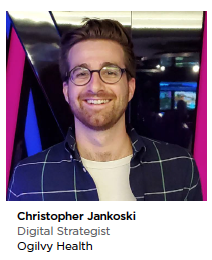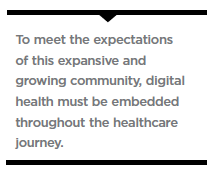 We’ve all heard the term “flatten the curve" to describe the efforts being made to curb infection rates of COVID-19, but today’s tumultuous climate is disrupting another curve — the adoption curve of digital health. In 2019, a survey revealed that two-thirds of patients were open to the idea of telehealth, but only 8% had tried it. A 2020 report showed that half of patients surveyed had tried telehealth within the previous three months, and 83% of those patients reported they expected to use telehealth even after the COVID-19 pandemic has been tamed. Simply put, what used to be a proportionate adoption curve has turned into an “all aboard" call to embrace telehealth and other digital health engagement out of necessity for accessing care. In 2020, it is practically a mandate that everyone become digital natives.
We’ve all heard the term “flatten the curve" to describe the efforts being made to curb infection rates of COVID-19, but today’s tumultuous climate is disrupting another curve — the adoption curve of digital health. In 2019, a survey revealed that two-thirds of patients were open to the idea of telehealth, but only 8% had tried it. A 2020 report showed that half of patients surveyed had tried telehealth within the previous three months, and 83% of those patients reported they expected to use telehealth even after the COVID-19 pandemic has been tamed. Simply put, what used to be a proportionate adoption curve has turned into an “all aboard" call to embrace telehealth and other digital health engagement out of necessity for accessing care. In 2020, it is practically a mandate that everyone become digital natives.
Digital Natives
A digital native is traditionally known as “a person who has been familiar with computers, the internet, and other digital technology from a young age."1 Technology has been embedded throughout these individuals’ lives, both as a form of entertainment and a life tool.
Today’s COVID-19 era has thrust everyone into the deep end of this digital native category. No longer is video conferencing a nice alternative to an in-person doctor visit — it’s become essential for immunocompromised patients, as well as for those concerned about putting compromised family members at risk. And healthcare professionals who may not have grown up with an iPad in their hands are being required to facilitate the tech-enabled interface, leverage advanced features, and become telehealth authorities for patients facing life-altering news.
Although this rapid adoption has altered how individuals adjust their expectations of what an office visit entails, it also opens the doors for new and improved engagements along the healthcare journey. This is not about repurposing your brand’s physical brochure into a PDF. It’s about shifting the way we think about how people are engaging with your brand and content. Here are three questions that can spark this reimagination of digital health activities in the wake of COVID-19:
Question No. 1: How can we adjust when we engage audiences?
The context of a doctor visit has changed the way we “show up."
Transportation to an appointment has been replaced with opening a laptop screen. This context is supremely important as we look to deliver messaging in a relevant way.
Virtual waiting rooms are a great way to prime patients/caregivers for relevant conversations they will be having with their physicians.
Delivering downloadable takeaway materials in chapters or sections at different times instead of in one long document may improve engagement and retention. Delivering relevant “how to" content before the adoption of a new treatment can improve the experience, ease anxiety, and build social capital for your brand. As we all become digital natives, audiences will come to expect these kinds of contextual engagements.
Question No. 2: How are we planning for the sharing of knowledge and communications?
There are countless micro-experiences that go into an overall virtual visit. One key experience is the sharing of materials before, during, and after the virtual visit. We, as marketers, need to be asking the right questions to continually optimize these experiences. Are multilingual resources required? Are there accessibility considerations like text size and contrast? Who should be sharing this content (HCPs, brands, reps, etc)? Which format of sharing makes the most sense (text, video, audio, etc.)? Addressing these questions will ensure your messaging is both optimized for the hand-off between audiences, and positions your brand as a forward-thinking partner.
Question No. 3: How are we making engagements memorable?
 Your healthcare communications before, during, and after telehealth visits aren’t just competing with other healthcare communications. They are competing with the Facebook or email notification that flashes on a patient’s phone and countless other activities people are doing online. As we all move further into the digital native category, marketers must be committed to diving even further into what tech-enabled experiences can offer.
Your healthcare communications before, during, and after telehealth visits aren’t just competing with other healthcare communications. They are competing with the Facebook or email notification that flashes on a patient’s phone and countless other activities people are doing online. As we all move further into the digital native category, marketers must be committed to diving even further into what tech-enabled experiences can offer.
Embracing social media as more than an ad-serving unit but rather as a forum to authentically engage with and learn from audiences, as well as provide a destination for returning value, is one way to ensure your brand is meeting the evolving expectations of digital natives.
Embedding Digital Through the Journey
Being consistently mindful of these questions and considerations will keep us thinking like digital natives. To meet the expectations of this growing community, digital health must be embedded throughout the healthcare journey. As we continue to seek out new and more targeted ways to deliver life-changing communications, it’s essential they be created in the context of our digital native lives.(PV)
Note: 1. https://www.dictionary.com/browse/digital-native
Ogilvy Health makes brands matter by keeping our audiences’ health, healthcare and wellness needs at the center of every touchpoint.
For more information, visit ogilvyhealth.com.








